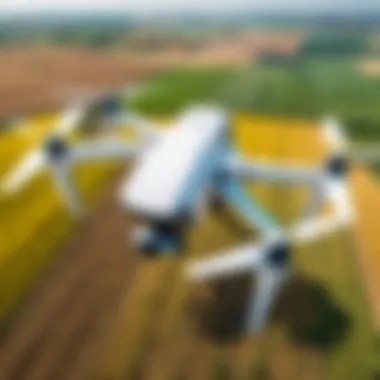Agtek Drone Technology: Revolutionizing Industries


Intro
Agtek drone technology has emerged as a pivotal tool in various industries, transforming data collection and project management processes. The integration of drone technology into professional settings allows for enhanced data acquisition, improved operational efficiency, and a comprehensive understanding of project landscapes. This article delves into the specifics of Agtek’s offerings, examining the technical aspects, user experiences, and the implications of this technology on future workflow strategies.
Software Overview
Software Description
Agtek offers a suite of software solutions tailored for drone-based data processing. This software allows users to upload and analyze high-resolution imagery captured by drones. The primary aim is to facilitate real-time data processing that supports critical decision-making in sectors like construction, agriculture, and surveying. By streamlining workflows and enhancing accessibility to vital information, the Agtek software suite represents a significant advancement over traditional data collection methods.
Key Features
The key features of Agtek drone technology software include:
- Data Integration: Seamlessly integrates with CAD, GIS, and other essential data systems to enhance usability.
- 3D Modeling Capabilities: Allows users to generate accurate 3D models of landscapes and project sites.
- Volume Calculation: Automated tools for real-time volume calculations based on drone data.
- Analysis Tools: Comprehensive data analysis tools that provide insights into site conditions, helping professionals make informed decisions.
Each feature is designed to enhance productivity and provide depth in data interpretation, making it a valuable resource for users.
User Experience
User Interface and Design
The user interface of Agtek software prioritizes intuitiveness. Users report that navigation is straightforward, which contributes to a less steep learning curve. The design emphasizes clarity, allowing even those with minimal technical background to utilize its features effectively. Moreover, visual representations of data make it easier to interpret complex information.
Performance and Reliability
In terms of performance, Agtek drone technology provides reliable data collection and processing capabilities. Users experience consistent software updates, ensuring that the platform remains at the forefront of technological advancements. Additionally, the processing speed is optimized to handle large datasets efficiently.
"The ability of Agtek technology to provide real-time insights is invaluable in project management."
This reliability supports a wide variety of applications and solidifies Agtek's presence in the market.
Closure
Agtek drone technology stands at the intersection of innovation and practical application. This overview highlights its capacity to reshape how professionals across industries gather and analyze data, ultimately resulting in better-informed decisions. The future of Agtek technology appears promising as it continues to evolve, adapting to the growing demands of consumers and technology alike.
Preamble to Agtek Drones
The emergence of drone technology has reshaped various sectors, particularly in data collection and project management. Agtek drones, specifically designed for industrial applications, are pivotal in this transformation. This section introduces the significance of Agtek drones and their role in enhancing operational efficiency and accuracy.
Overview of Drone Technology
Drone technology has evolved drastically over the past decade. Drones, also known as unmanned aerial vehicles (UAVs), use advanced sensors and imaging technology to gather data from above. They are equipped with cameras, GPS, and other tools that facilitate aerial mapping, surveying, and monitoring.
The integration of drone technology into industries offers a host of advantages. Traditional methods of data collection, often time-consuming and prone to human error, are being replaced by the efficiency of drones. This is particularly beneficial in sectors like construction and agriculture, where timely and accurate data is crucial for decision-making.
The Role of Agtek in the Drone Landscape
Agtek is recognized as a leader in providing sophisticated drone solutions tailored for various industrial needs. Its drones are engineered with specific functionalities that set them apart in the competitive landscape. Their applications extend beyond mere aerial photography; they encompass comprehensive data management processes that enhance productivity.
Agtek drones excel in areas such as:
- Site surveys in construction, offering precise measurements and updates in real-time.
- Crop monitoring in agriculture, delivering actionable insights on crop health and yield predictions.
Agtek stands at the forefront of integrating technology with practical applications, pushing the boundaries of what drones can accomplish. As industries become more dependent on accurate data, the relevance of Agtek's innovations continues to grow, positioning it as a crucial player in the drone revolution.
Technical Specifications of Agtek Drones
The technical specifications of Agtek drones play a critical role in determining their usability and effectiveness across different applications. Understanding these characteristics enables users to choose the right model for their specific needs, ensuring optimal performance. In this section, we will examine essential hardware features, focusing on camera capabilities, battery life, and payload capacity. Additionally, we will delve into software integration, highlighting mapping and surveying software alongside data processing tools. Each element of these specifications contributes significantly to the utility and operational efficiency of Agtek drones, making this an important area of study for those interested in drone technology.
Hardware Features


Hardware specifications define the foundational capabilities of Agtek drones. They inform potential users about what tasks the drones can handle and how effectively they can operate in various environments.
Camera Capabilities
One of the standout features of Agtek drones is their camera capabilities. The high-resolution cameras available on these drones not only capture detailed images but also allow for extensive surveillance and monitoring. High-definition imaging supports applications in construction, agriculture, and environmental studies.
A key characteristic of these cameras is their ability to provide multispectral imaging. This feature allows users to assess health indicators of crops or monitor site conditions with precision. The advantage of using Agtek drones with advanced camera systems is evident in the accuracy of data collected and the efficiency in achieving project goals.
However, a disadvantage may arise in complex lighting conditions. In such scenarios, image quality may be compromised, affecting data integrity. Despite this limitation, the camera capabilities remain a strong selling point for Agtek drones.
Battery Life
Battery life is crucial for ensuring operational efficiency. Drones with longer battery life can cover more ground, allowing for extended flights without the need for frequent recharges. Agtek drones generally boast improved battery technology, which contributes to their increased usage time.
The standout feature within this aspect is the energy density of the batteries used. This characteristic supports longer flights, which is particularly beneficial in tasks such as large area surveys or remote monitoring. A longer operational window helps users maximize productivity.
Nonetheless, users should consider environmental factors affecting battery performance, such as extreme temperatures. Low battery output under harsh conditions could pose challenges during crucial operations. Overall, the battery life of Agtek drones remains an essential attribute impacting their practicality.
Payload Capacity
Payload capacity refers to the maximum weight a drone can carry. This aspect is important when users need to transport various sensors and equipment. Agtek drones are designed with substantial payload capabilities, allowing them to carry diverse accessories tailored to specific tasks.
A prominent feature is the modular design, which facilitates easy adjustments based on different project requirements. This flexibility means users can customize their drone's setup according to the specific demands of their work.
However, there is a threshold to how much weight can be added without affecting flight stability and performance. Exceeding the capacity can lead to reduced efficiency or even accidents. Therefore, understanding the limits of payload capacity is essential for safe and effective drone operation.
Software Integration
The integration of software with Agtek drones enhances their functional capabilities. This component includes mapping and surveying software as well as data processing tools, directly impacting the quality and usability of the data collected.
Mapping and Surveying Software
Mapping and surveying software is a key aspect of Agtek drones that streamlines data collection. This software converts aerial images into valuable geographical data, providing insights for sectors like construction and agriculture.
The standout feature here includes automated flight planning, which optimizes flight paths for comprehensive data capture. This increases efficiency and reduces human error in the data gathering process. The software's capability to produce detailed 3D maps can greatly enhance project visibility.
However, users must confront the learning curve associated with these sophisticated tools. Effective utilization demands time for proper training and experience. Despite this hurdle, the benefits of integrating mapping software ultimately outweigh the challenges.
Data Processing Tools
Data processing tools are essential for analyzing and interpreting the information gathered by Agtek drones. These tools help in generating actionable insights from the raw data collected during flights.
The key characteristic of these tools is their ability to handle large data sets efficiently. This is particularly beneficial for industries dealing with vast areas or multiple projects at once. The software typically provides visualization options, which can enhance understanding and reporting.
Nevertheless, the complexity of data can lead to difficulties in obtaining clear insights. Users must approach data interpretation with careful consideration to avoid misconceptions. While there are nuances to navigate, the value of sophisticated data processing tools marks a significant advantage for Agtek users.
"The technical specifications of Agtek drones are not merely numbers; they represent the potential to revolutionize workflows in various industries."
Understanding these technical specifications is essential for maximizing the effectiveness of Agtek drones in real-world applications. Skilled operators can leverage these characteristics to achieve impressive results across an array of settings.
Applications in Various Industries
The application of Agtek drones in diverse industries underscores their versatility and significance. These sophisticated machines have become vital tools in enhancing operational efficiency, improving data collection methods, and providing real-time insights. Their capabilities allow organizations in construction, agriculture, and environmental studies to address complex challenges more effectively. Understanding these applications can help stakeholders recognize the value Agtek drones bring to their specific fields.
Construction and Engineering
Site Surveys
Site surveys utilizing Agtek drones are essential for accurate data collection in construction projects. Drones capture high-resolution aerial images that facilitate detailed topographical mapping, which is fundamental to project planning. One of the key characteristics of site surveys is their ability to cover large areas quickly, allowing for comprehensive site analysis without the traditional limitations associated with manual surveys. This efficiency makes drones a popular choice for construction teams aiming to save time and reduce labor costs. However, despite their advantages, accuracy can be affected by various factors, including terrain complexity and weather conditions, which need careful consideration.
Progress Monitoring
Agtek drones are instrumental in progress monitoring during construction projects. They provide continuous updates on site activity, allowing managers to track developments in real-time. The key characteristic of this application is its capacity for frequent aerial surveys, which help identify delays or deviations from planned schedules. Using drones in progress monitoring is beneficial, as it offers visual documentation that can be easily shared with stakeholders. Nevertheless, it is crucial to maintain regular aerial surveillance to ensure that the data remains relevant and actionable.


Agriculture
Crop Monitoring
In agriculture, crop monitoring through Agtek drones enables farmers to assess plant health from above. Drones equipped with specialized cameras can capture data on crop vigor, allowing for timely interventions. A significant advantage of using drones for this task is the ability to analyze vast fields quickly, providing farmers actionable insights into their crops' conditions. While crop monitoring is generally effective, it relies on the correct calibration of sensors and understanding of agricultural practices to be truly beneficial.
Precision Agriculture
Precision agriculture represents another area where Agtek drones offer considerable contributions. This approach involves using drone-collected data to manage field variability in crops. One of the defining features of precision agriculture is its data-driven methodology, ensuring optimal resource allocation and yield maximization. The use of drones can significantly enhance this practice by enabling targeted treatments in affected areas. However, the initial investment in drone technology and training can be a barrier for some farmers, which should be accounted for when considering implementation.
Environmental Studies
Wildlife Tracking
Wildlife tracking is a critical application of Agtek drones in environmental studies. Drones provide researchers with the ability to monitor wildlife habitats from a non-intrusive vantage point. This capability is particularly useful for tracking migration patterns and assessing ecological impacts without disturbing animal activities. The key advantage lies in the collection of data over extensive areas that may be logistically challenging to survey on foot. Nevertheless, challenges remain in ensuring that the drones operate quietly and safely to avoid stressing wildlife.
Conservation Efforts
Agtek drones play an important role in various conservation efforts. They are used for monitoring endangered species and their habitats, providing crucial data that informs conservation strategies. A distinctive feature of these efforts is their capability to gather data in hard-to-reach areas, enabling more comprehensive resource management. Conservationists benefit from the aerial perspective of drones, but regulatory requirements regarding airspace and privacy need careful navigation to ensure compliance with local laws.
Understanding the applications of Agtek drones in industries reveals their transformative potential. Efficiency, accuracy, and safety are just a few benefits that make them indispensable tools across various sectors.
Benefits of Using Agtek Drones
Agtek drones provide numerous advantages that enhance operational efficiency across different sectors. As industries increasingly shift towards data-driven decision making, these drones stand out for their ability to produce high-quality outputs. Understanding these benefits offers valuable insights into how organizations can optimize their operations through drone technology.
Enhanced Data Accuracy
Data accuracy is crucial in any operational context. Agtek drones are equipped with advanced sensors and high-resolution cameras that capture information with precision. This technology helps create detailed maps and models that reflect the current state of projects accurately.
Key aspects of enhanced data accuracy include:
- High-resolution imagery: The cameras on Agtek drones allow for clear and detailed images. This detail is vital for surveying and monitoring.
- Real-time data capture: Drones can gather data instantly, reducing the chances of human error inherent in manual data collection processes.
- Consistent results: Automated data capture ensures that the information collected is uniform across various surveys, allowing for reliable comparisons.
The combination of these features allows organizations to make informed decisions based on factual data. With Agtek drones, operations become transparent, leading to better project outcomes.
Cost Efficiency
Cost considerations are often at the forefront when implementing new technologies. Agtek drones contribute to significant cost savings across several domains.
- Reduced labor costs: Drones decrease the need for manual labor in surveying and monitoring tasks, allowing businesses to allocate resources elsewhere.
- Minimal equipment investment: Compared to traditional surveying tools, drones represent a lower upfront investment. The operational costs are also reduced due to less equipment wear and tear.
- Long-term savings: While initial acquisition may require capital, the efficiencies gained translate to long-term savings. Regular use of Agtek drones enhances productivity, helping businesses maximize their return on investment.
As organizations recognize these financial benefits, the shift towards drone utilization continues to grow.
Time Savings
Time efficiency plays a vital role in project management. Agtek drones allow for rapid data collection and analysis, streamlining processes that traditionally consume substantial time.
Consider the following:
- Quick surveys: Drones can complete site surveys in a fraction of the time it would take traditional methods. This speed accelerates project timelines.
- Rapid data analysis: After data capture, integrated software can process information swiftly, enabling quick access to insights and analyses.
- Scheduling flexibility: Drones can operate in various conditions and times, providing flexibility that traditional methods lack.
Overall, the ability to save time translates into enhanced productivity. By adopting Agtek drones, businesses can meet deadlines more effectively, driving success in their projects.
Agtek drones offer heightened accuracy, cost-efficiency, and time savings, making them invaluable tools in modern project management.
Challenges and Limitations
In the evolving landscape of Agtek drone technology, understanding the challenges and limitations is critical. These factors can significantly influence deployment and effectiveness across various sectors. While the capabilities of Agtek drones are impressive, the hurdles that accompany their use necessitate careful consideration and strategic planning. This section will delve into specific challenges, including regulatory hurdles, technical limitations, and public perception issues.
Regulatory Hurdles


Regulatory hurdles present an essential challenge in the adoption of Agtek drones. Different countries have specific laws governing drone usage, often resulting in complex compliance procedures. Governing bodies require operators to obtain licenses, adhere to no-fly zones, and follow safety guidelines. These regulations can slow down project timelines and increase costs.
The importance of addressing regulatory hurdles cannot be overstated. Organizations must navigate these complexities to ensure legal compliance. Failing to do so may result in penalties. Understanding local laws can also shape how companies deploy drone technology in the field.
Technical Limitations
Weather Dependency
Weather dependency is a significant technical limitation for Agtek drones. Drones are often not operable during severe weather conditions, including heavy rain, strong winds, and snow. The reliance on favorable weather conditions means that operational windows can be limited.
This characteristic of weather dependency can lead to delays in data collection and project execution. While this is a clear disadvantage, it also highlights the need for planning and strategy in project timelines. Operators must account for possible weather disruptions when scheduling flights and should have contingency plans in place.
Range Limitations
Range limitations define how far an Agtek drone can operate effectively from its controller. If a drone exceeds its communication range, it may lose connection, resulting in potential mission failure. This characteristic is vital as it determines operational boundaries for projects requiring extensive area coverage.
Range limitations can also present logistical challenges. Companies must consider the distances involved in their operations and possibly invest in multiple drones for larger sites. Addressing range limits often requires technology enhancements or supplementary equipment, affecting overall project costs.
Public Perception Issues
Public perception issues comprise another challenge in the domain of Agtek drones. Concerns around privacy, security, and safety can hinder acceptance within communities. Some individuals fear that drones may intrude on their privacy or be misused in ways that pose risks.
It is crucial for organizations to engage with the public and communicate the benefits of drone technology clearly. Establishing trust and addressing concerns can help mitigate these issues. Creating informative campaigns that educate communities about the functions and safeguards of drone technology can foster a more favorable public view.
"The awareness of benefits combined with a transparent operational approach can improve public perception and acceptance of drone technology."
Understanding these challenges—regulatory hurdles, technical limitations, and public perception issues—is essential for effectively implementing Agtek drone technology. Addressing these factors allows for better preparation and successful integration into various projects.
Future Developments in Agtek Drone Technology
The field of drone technology is evolving rapidly, with Agtek standing at the forefront of several exciting advancements. Future developments in Agtek drone technology promise profound shifts in capabilities and applications. By honing in on key innovations and integrating sophisticated systems, these advancements could redefine the operational landscape for professionals across various industries.
By expecting innovation, stakeholders can begin preparing for the new possibilities. Dron technology may allow for more efficient processes, higher data collection accuracy, and better decision-making capabilities. Beyond simply enhancing performance, these innovations will also change how businesses approach challenges and seize opportunities. These elements mark a crucial phase in the ongoing integration of technology in industry.
Innovations on the Horizon
Innovations within Agtek drone technology include a range of improvements to both hardware and software components. As hardware capabilities expand, drones are likely to feature enhanced sensors and cameras that provide greater detail and wider operational ranges. Expect future models equipped with multispectral or thermal imaging. This adds new possibilities for data analysis in fields like agriculture and construction.
Moreover, advancements in battery technology will play a significant role. Longer-lasting batteries lead to extended flight times and reduce downtime significantly. This is crucial for industries relying on extensive data gathering in challenging environments.
On the software side, developments in data processing and mapping software will enhance user experience. With more intuitive interfaces, professionals can extract insights rapidly, thereby making quicker decisions in various projects. Just imagine a scenario where real-time data feeds enable ongoing project adjustments.
"As technology advances, the capabilities of Agtek drones will not just improve but will also drive entirely new business models in various sectors."
Integration with Artificial Intelligence
The incorporation of Artificial Intelligence (AI) in Agtek drones represents one of the most significant prospects for the future. AI can facilitate improved data processing, enabling drones to analyze data on the fly. Machine learning models can enhance data accuracy and minimize human error, leading to cleaner datasets and more reliable insights.
In practical applications, imagine drones being able to identify patterns or anomalies autonomously during flights—eliminating the need for extensive post-flight analysis. This efficiency is particularly beneficial in agriculture, where time-sensitive decisions impact yields.
AI can also impact operational aspects. Drones integrated with AI systems can optimize flight paths and reduce energy consumption. These efficiencies can translate directly into cost savings for businesses. Additionally, AI drones can work collaboratively in swarms, completing tasks faster and more effectively than traditional methods.
To conclude, the future of Agtek drone technology is filled with potential. As advancements in hardware, software, and AI unfold, they will likely redefine the role of drones in industries. Stakeholders should remain vigilant and adaptable, as these changes will necessitate new strategies for operation and implementation.
Ending
In discussing the trajectory of Agtek drone technology, it is essential to recognize its profound significance within various industries. The exploration presented in this article emphasizes how Agtek drones not only enhance efficiency but also enable a level of precision that was previously unattainable. As we summarize the insights, it becomes clear that these drones stand as a testament to the advancements in aerial data collection and analysis.
Summary of Insights
Agtek drones offer unique advantages that set them apart in the crowded landscape of drone technology. They are equipped with advanced camera capabilities, ensuring high-resolution imagery that enhances data accuracy. Furthermore, the software integration allows users to engage in complex mapping and surveying tasks with remarkable ease, underscoring the importance of robust data processing tools. These features collectively enable users to make informed decisions based on reliable insights, thus improving operational workflows and project outcomes.
The Path Forward for Users and Developers
Looking to the future, the path forward for users and developers of Agtek drone technology holds a promising vision. The ongoing innovations point to a trajectory where integration with artificial intelligence and machine learning capabilities will further enhance operational efficiencies. For users, this means a future where drones are not just tools but integral components of strategic decision-making processes. For developers, the expectation is to prioritize user-centric advancements which address the emerging needs in industries such as construction, agriculture, and environmental monitoring. As the technology matures, collaboration among stakeholders will be crucial in harnessing the full potential of Agtek drones, crafting solutions that resonate with the evolving demands of the market.
"The future of drone technology is not merely about flying machines; it’s about data, insight, and transformative applications that redefine industries."
In essence, the consolidation of insights provided throughout this article serves not only as a reflection of Agtek drone capabilities but also as a guide for its future. With the right focus, Agtek can lead the charge toward a more efficient and data-driven world, empowering businesses and enhancing operational capacities.







